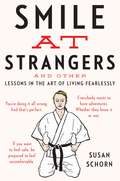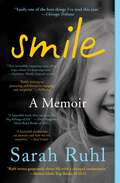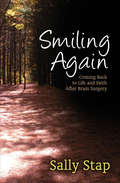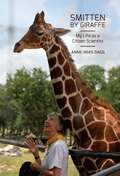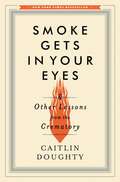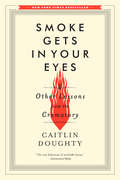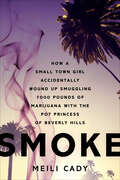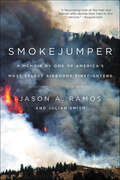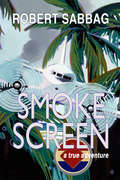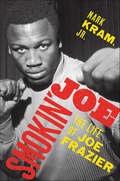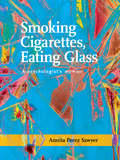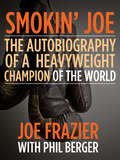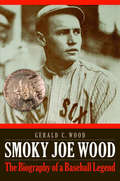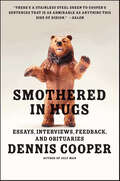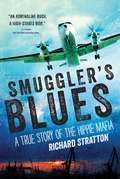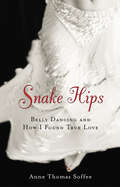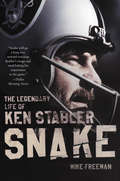- Table View
- List View
Smile at Strangers: And Other Lessons in the Art of Living Fearlessly
by Susan Schorn"Eat, pray . . . kick ass. Delivered with self-deprecating candor, Schorn's life lessons learned at the dojo will resonate with anyone who's ever tried to remodel a house, raise kids, cope with a health crisis, navigate office politics or hyperventilated--essentially anyone who's ever been slammed on the mat while testing for the black belt of life. Like the fighter herself, you can't put this one down."--Mary Moore, author of The Unexpected When You're ExpectingSusan Schorn led an anxious life. For no clear reason, she had become progressively paralyzed by fear. Fed up with feeling powerless, she took up karate. She learned how to say no and how to fight when you have to (even in the dark). Karate taught her how to persuade her husband to wear a helmet, best one bossy Girl Scout troop leader, and set boundaries with an over-sharing boss. Here this double black belt recounts a fighting, biting, laughing woman's journey on the road to living fearlessly--where enlightenment is as much about embracing absurdity and landing a punch as about finding that perfect method of meditation.Full of hilarious hijinks and tactical wisdom, Schorn's quest for a more satisfying life features practical--and often counterintuitive--lessons about safety and self defense. Smile at strangers, she says. Question your habits, your fears, your self-criticism: Self-criticism is easy. Self-improvement is hard. And don't forget this essential gem: Everybody wants to have adventures. Whether they know it or not. Join the adventure in these pages, and come through it poised to have more of your own.
Smile, You're Traveling
by Henry RollinsSmile, You're Traveling is the third installment in the Black Coffee Blues series of books (which include Black Coffee Blues and Do I Come Here Often?). This time around Rollins reports from show tours and frequent flier financed travel during 1997 and 1998. Whether being terrified by roving gangs of baboons in Kenya or haggling with immigration officials over visa charges in Madagascar, Rollins finds a way to make his unique experiences universal. Says our weather beaten scribe of his journeys, "Some of it was cool, some of it was a pain in the ass, or maybe that was just me."
Smile: The Story of a Face
by Sarah RuhlThe extraordinary story of one woman’s ten-year medical and metaphysical odyssey that brought her physical, creative, emotional, and spiritual healing, by a MacArthur genius and two-time Pulitzer finalist. <p><p> With a play opening on Broadway, and every reason to smile, Sarah Ruhl has just survived a high-risk pregnancy when she discovers the left side of her face is completely paralyzed. She is assured that 90 percent of Bell’s palsy patients see spontaneous improvement and experience a full recovery. Like Ruhl’s own mother. But Sarah is in the unlucky ten percent. And for a woman, wife, mother, and artist working in theater, the paralysis and the disconnect between the interior and exterior brings significant and specific challenges. So Ruhl begins an intense decade-long search for a cure while simultaneously grappling with the reality of her new face—one that, while recognizably her own—is incapable of accurately communicating feelings or intentions. <p><p> In a series of piercing, witty, and lucid meditations, Ruhl chronicles her journey as a patient, wife, mother, and artist. She explores the struggle of a body yearning to match its inner landscape, the pain of postpartum depression, the story of a marriage, being a playwright and working mom to three small children, and the desire for a resilient spiritual life in the face of illness. Brimming with insight, humility, and levity, Smile is a triumph by one of America’s leading playwrights. It is an intimate examination of loss and reconciliation, and above all else, the importance of perseverance and hope in the face of adversity.
Smiling Again: Coming Back to Life and Faith After Brain Surgery
by Sally StapThe &“poignant account of one woman&’s struggle for health and faith—and the tireless devotion of family&” in the face of a devastating illness (Peter DeHaan, PhD). Sally Stap was living a happy life with a successful career, juggling the usual concerns about job, daughters, and everyday obligations. But her world was shattered when she was diagnosed with an acoustic neuroma—a benign but large brain tumor that would require a major invasive operation to remove. Smiling Again is a story of perseverance and appreciating the beauty of life in spite of pain. Writing with a poignant blend of honesty, dry humor, faith, and inquisitiveness, Sally recounts the shock of diagnosis, the long and painful process of recovery, her eventual retirement due to disability, and ultimately the contentment she found in accepting a new life journey. No matter what trials you may face, Sally&’s experience teaches us that even when the worst happens, God is still present and visible—sometimes in unexpected ways. Your future self may be different from who you were before, but those changes can lead you in new and rewarding directions.
Smith Wigglesworth: Apostle of Faith
by Stanley Howard FrodshamSMITH WIGGLESWORTH constantly acknowledged how much he owed under God to a wonderful wife, but he was also equally grateful for a remarkable daughter. We first visited his home in 1909 when Alice Wigglesworth was spending her first term in Africa. The constant theme of his conversation from morning until night was "our Alice." After the home-going of Mrs. Wigglesworth in 1913, Alice Wigglesworth--who was later married to James Salter--in large manner took the place of her mother, traveling constantly with her father in his many journeys to different countries. Especially was this so during the last years of his life. Mrs. Salter herself had an inspiring ministry like her mother's, and Mr. Wigglesworth encouraged her constantly to stir up the saints with her fiery message before he himself gave forth the Word.
Smitten by Giraffe: My Life as a Citizen Scientist
by Anne DaggWhen Anne Innis saw her first giraffe at the age of three, she was smitten. She knew she had to learn more about this marvelous animal. Twenty years later, now a trained zoologist, she set off alone to Africa to study the behaviour of giraffe in the wild. Subsequently, Jane Goodall and Dian Fossey would be driven by a similar devotion to study the behaviour of wild apes. In Smitten by Giraffe, the noted feminist reflects on her scientific work as well as the leading role she has played in numerous activist campaigns. On returning home to Canada, Anne married physicist Ian Dagg, had three children, published a number of scientific papers, taught at several local universities, and in 1967 earned her PhD in biology at the University of Waterloo. Dagg was continually frustrated in her efforts to secure a position as a tenured professor despite her many publications and exemplary teaching record. Finally she opted instead to pursue her research as an independent "citizen scientist," while working part-time as an academic advisor. Dagg would spend many years fighting against the marginalization of women in the arts and sciences. Boldly documenting widespread sexism in universities while also discussing Dagg's involvement with important zoological topics such as homosexuality, infanticide, sociobiology, and taxonomy, Smitten by Giraffe offers an inside perspective on the workings of scientific research and debate, the history of academia, and the rise of second-wave feminism.
Smitten by Giraffe: My Life as a Citizen Scientist (Footprints Series #28)
by Anne DaggWhen Anne Innis saw her first giraffe at the age of three, she was smitten. She knew she had to learn more about this marvellous animal. Twenty years later, now a trained zoologist, she set off alone to Africa to study the behaviour of giraffe in the wild. Subsequently, Jane Goodall and Dian Fossey would be driven by a similar devotion to study the behaviour of wild apes.In Smitten by Giraffe the noted feminist reflects on her scientific work as well as the leading role she has played in numerous activist campaigns. On returning home to Canada, Anne married physicist Ian Dagg, had three children, published a number of scientific papers, taught at several local universities, and in 1967 earned her PhD in biology at the University of Waterloo. Dagg was continually frustrated in her efforts to secure a position as a tenured professor despite her many publications and exemplary teaching record. Finally she opted instead to pursue her research as an independent “citizen scientist,” while working part-time as an academic advisor. Dagg would spend many years fighting against the marginalization of women in the arts and sciences.Boldly documenting widespread sexism in universities while also discussing Dagg’s involvement with important zoological topics such as homosexuality, infanticide, sociobiology, and taxonomy, Smitten by Giraffe offers an inside perspective on the workings of scientific research and debate, the history of academia, and the rise of second-wave feminism. A new preface relates Dagg’s experience as the subject of the documentary The Woman Who Loves Giraffes.
Smoke Gets in Your Eyes: And Other Lessons from the Crematory
by Caitlin DoughtyMost people want to avoid thinking about death, but Caitlin Doughty--a twenty-something with a degree in medieval history and a flair for the macabre--took a job at a crematory, turning morbid curiosity into her life's work. Thrown into a profession of gallows humor and vivid characters (both living and very dead), Caitlin learned to navigate the secretive culture of those who care for the deceased. Smoke Gets in Your Eyes tells an unusual coming-of-age story full of bizarre encounters and unforgettable scenes. Caring for dead bodies of every color, shape, and affliction, Caitlin soon becomes an intrepid explorer in the world of the dead. She describes how she swept ashes from the machines (and sometimes onto her clothes) and reveals the strange history of cremation and undertaking, marveling at bizarre and wonderful funeral practices from different cultures. Her eye-opening, candid, and often hilarious story is like going on a journey with your bravest friend to the cemetery at midnight. She demystifies death, leading us behind the black curtain of her unique profession. And she answers questions you didn't know you had: Can you catch a disease from a corpse? How many dead bodies can you fit in a Dodge van? What exactly does a flaming skull look like?Honest and heartfelt, self-deprecating and ironic, Caitlin's engaging style makes this otherwise taboo topic both approachable and engrossing. Now a licensed mortician with an alternative funeral practice, Caitlin argues that our fear of dying warps our culture and society, and she calls for better ways of dealing with death (and our dead).
Smoke Gets in Your Eyes: And Other Lessons from the Crematory
by Caitlin DoughtyA young mortician goes behind the scenes, unafraid of the gruesome (and fascinating) details of her curious profession. Most people want to avoid thinking about death, but Caitlin Doughty--a twenty-something with a degree in medieval history and a flair for the macabre--took a job at a crematory, turning morbid curiosity into her life's work. Thrown into a profession of gallows humor and vivid characters (both living and very dead), Caitlin learned to navigate the secretive culture of those who care for the deceased. Smoke Gets in Your Eyes tells an unusual coming-of-age story full of bizarre encounters and unforgettable scenes. Caring for dead bodies of every color, shape, and affliction, Caitlin soon becomes an intrepid explorer in the world of the dead. She describes how she swept ashes from the machines (and sometimes onto her clothes) and reveals the strange history of cremation and undertaking, marveling at bizarre and wonderful funeral practices from different cultures. Her eye-opening, candid, and often hilarious story is like going on a journey with your bravest friend to the cemetery at midnight. She demystifies death, leading us behind the black curtain of her unique profession. And she answers questions you didn't know you had: Can you catch a disease from a corpse? How many dead bodies can you fit in a Dodge van? What exactly does a flaming skull look like? Honest and heartfelt, self-deprecating and ironic, Caitlin's engaging style makes this otherwise taboo topic both approachable and engrossing. Now a licensed mortician with an alternative funeral practice, Caitlin argues that our fear of dying warps our culture and society, and she calls for better ways of dealing with death (and our dead).
Smoke In The Lanes: Happiness and Hardship on the Road with the Gypsies in the 1950s
by Dominic ReeveIn the 1950s the Romani people lived on the brink of great change. In their bright wooden wagons they journeyed between horse-fairs and traditional stopping places - stoic, humorous and wild, often poverty-stricken but protective of their freedom - on the fringes of a society that was soon to close around them. Dominic Reeve describes his life among the Gypsies: the feuds and fairs, the joyful muddy squalor of an outdoor existence. He evokes an unforgettable cast of fireside characters - bold children, fierce matriarchs and dandyish villains in snap-brimmed hats - and tells of sharp deals done and rings run round country policemen, of love affairs, dances and open-air feasting. Smoke in the Lanes is the vivid, memorable record of a disappeared world.
Smoke in the Lanes: Happiness and Hardship on the Road with the Gypsies in the 1950s
by Dominic ReeveIn the 1950s the Romani people lived on the brink of great change. In their bright wooden wagons they journeyed between horse-fairs and traditional stopping places - stoic, humorous and wild, often poverty-stricken but protective of their freedom - on the fringes of a society that was soon to close around them. Dominic Reeve describes his life among the Gypsies: the feuds and fairs, the joyful muddy squalor of an outdoor existence. He evokes an unforgettable cast of fireside characters - bold children, fierce matriarchs and dandyish villains in snap-brimmed hats - and tells of sharp deals done and rings run round country policemen, of love affairs, dances and open-air feasting. Smoke in the Lanes is the vivid, memorable record of a disappeared world.
Smoke: How a Small-Town Girl Accidentally Wound Up Smuggling 7,000 Pounds of Marijuana with the Pot Princess of Beverly Hills
by Meili CadyCombining the excess of The Bling Ring with the intimacy of Blow and the charm of Catch Me If You Can, an outrageous, entertaining and true story of an aspiring young actress’ ill-fated friendship and unwitting alliance with a drug smuggling “heiress.”Aspiring actress Meili Cady left small-town Washington State for the glamorous lure of Los Angeles. Young and alone, she was struggling to make her big break. Then she met Lisette Lee. Calling herself the “Korean Paris Hilton,” Lisette claimed she was a model and a Korean pop star, lived in a $1.2 million dollar apartment in West Hollywood, owned a fleet of luxury cars, and flitted from one red-carpet event to the next.The connection was instant. Meili was enchanted by her friend’s extravagant lifestyle, while Lee claimed Meili was the real thing in a town full of phonies. Soon, the financially strapped Meili became her friend’s personal assistant—and found herself sucked into an audacious criminal enterprise. But when Meili finally realized what she was a part of it was too late—she was in too deep, caught in a terrifying relationship with a manipulative and abrasive con artist smuggling millions of dollars of pot into the Midwest.Trapped in a precarious criminal world of money, drugs, and dangerous secrets, Meili struggled to understand the line between truth and lie. A once naive girl who fell down the rabbit hole, she could only watch helplessly as it all came crashing down around her. Smoke is her story—an electrifying tale of vice, corruption, hubris, and lost innocence as shocking and entertaining as The Wolf of Wall Street and Bringing Down the House.
Smokejumper: A Memoir by One of America's Most Select Airborne Firefighters
by Julian Smith Jason A. RamosA rare inside look at the thrilling world of smokejumpers, the airborne firefighters who parachute into the most remote and rugged areas of the United States, confronting the growing threat of nature’s blazes.Forest and wildland fires are growing larger, more numerous, and deadlier every year — record drought conditions, decades of forestry mismanagement, and the increasing encroachment of residential housing into the wilderness have combined to create a powder keg that threatens millions of acres and thousands of lives every year. One select group of men and women are part of America's front-line defense: smokejumpers. The smokejumper program operates through both the U.S. Forest Service and the Bureau of Land Management. Though they are tremendously skilled and only highly experienced and able wildland firefighters are accepted into the training program, being a smokejumper remains an art that can only be learned on the job. Forest fires often behave in unpredictable ways: spreading almost instantaneously, shooting downhill behind a stiff tailwind, or even flowing like a liquid. In this extraordinarily rare memoir by an active-duty jumper, Jason Ramos takes readers into his exhilarating and dangerous world, explores smokejumping’s remarkable history, and explains why their services are more essential than ever before.
Smokescreen
by Robert SabbagWith his drug-smuggling documentary short on financing, moving marijuana seemed the obvious way for cinematographer Allen Long to raise the necessary cash. Millions of dollars later the film had not been made, but Long's own life as a pioneering pot smuggler had played out like a Hollywood movie... seat-of-the-pants flights in a decrepit DC3 into the Colombian badlands, numerous near misses with law enforcement... fast boats, fashion models, fortunes earned and blown... From Mexico to Marin County, from the boardrooms of Manhattan to the midnight streets of Miami, Allen Long's true story is as entertaining as the greatest fiction, a hilarious piece of hair-raising reportage that will keep your pulse racing to the very last page.Robert Sabbag is the bestselling author of the classic Snowblind, Down Around Midnight and other works of nonfiction. His journalism appears in Rolling Stone, Men's Journal, New York, Playboy, The New York Times, The Los Angeles Times and other publications. He is co-writer of the film Witness Protection, based on his The New York Times Magazine cover story "The Invisible Family." It was nominated for two Golden Globe awards, including Best Picture.
Smokin' Joe: The Life of Joe Frazier
by Mark Kram Jr.An all-access biography of the boxer whose rivalry with Muhammad Ali riveted fans and whose legacy in American sports and society endures.“A comprehensive knockout of a biography. . . . A beautiful book.” —Wall Street JournalHistory will remember the rivalry of Joe Frazier and Muhammad Ali as one for the ages, a trilogy of extraordinary fights that transcended the world of sports and crossed into a sociocultural drama that divided the country.Joe Frazier was a much more complex figure than just his rivalry with Ali would suggest. In this riveting and nuanced portrayal, acclaimed sports writer Mark Kram, Jr. unlinks Frazier from Ali and for the first time gives a full-bodied accounting of Frazier’s life, a journey that began as the youngest of thirteen children packed in small farm house, encountering the bigotry and oppression of the Jim Crow South, and continued with his voyage north at age fifteen to develop as a fighter in Philadelphia.Tracing Frazier’s life through his momentous bouts with the likes of Ali and George Foreman and the developing perception of him as the anti-Ali in the eyes of blue-collar America, Kram follows the boxer through his retirement in 1981, exploring his relationship with his son, the would-be heavyweight Marvis, and his fragmented home life as well as the uneasy place that Ali continued to occupy in his thoughts.A propulsive and richly textured narrative that is also a powerful story about race and class in America, Smokin' Joe is unparalleled in its scope, depth, and access and promises to be the definitive biography of a towering American figure whose life was galvanized by conflict and whose mark has proven lasting.“This book is a revelation, a powerhouse, a thing of beauty, and . . . a knockout. . . . A biography worthy in every way of the champ’s greatness.” —Jonathan Eig, bestselling author of Ali: A Life“Marl Kram, Jr., much, much more than splendidly gets to the strange anomaly that was Smokin’ Joe. . . . His life story is worth reading.” —Richard Ford“Mark Kram, Jr.’s sympathetic and thoroughly researched Smokin’ Joe is a worthy introduction to an underappreciated American athlete.” —Joyce Carol Oates
Smoking Cigarettes, Eating Glass: A Psychologist's Memoir (Sfwp Literary Awards Ser.)
by Annita SawyerAnnita Sawyer's memoir is a harrowing, heroic, and redeeming story of her battle with mental illness, and her triumph in overcoming it. In 1960, as a suicidal teenager, Sawyer was institutionalized, misdiagnosed, and suffered through 89 electroshock treatments before being transfered, labeled as "unimproved." The damage done has haunted her life. Discharged in 1966, after finally receiving proper psychiatric care, Sawyer kept her past secret and moved on to graduate from Yale University, raise two children, and become a respected psychotherapist. That is, until 2001, when she reviewed her hospital records and began to remember a broken childhood and the even more broken mental health system of the 1950s and 1960s, Revisiting scenes from her childhood and assembling the pieces of a lost puzzle, her autobiography is a cautionary tale of careless psychiatric diagnosis and treatment, both 50 years ago and today. It is an informative story about understanding PTSD and making emotional sense of events that can lead a soul to darkness. Most of all, it's a story of perseverance: pain, acceptance, healing, hope, and success. Hers is a unique voice for this generation, shedding light on an often misunderstood illness.
Smokin’ Joe: The Autobiography of a Heavyweight Champion of the World, Smokin’ Joe Frazier
by Phil Berger Joe FrazierWhen boxing was bold, bright, and glamorous and the fights were the hottest sporting events of the year, Joe Frazier was king as the Heavyweight Champion of the World. From 1970 to 1973 he reigned. With a career record of 32-4-1 with twenty-seven knockouts and an Olympic gold medal, Frazier leaves little question that he was one of the greatest fighters of all time. Well-known, loved, and revered as a gentleman and a fierce competitor in the ring, Joe Frazier speaks his mind in Smokin' Joe--about growing up poor and fighting in the first $2.5 million bout; about the early days of his friendship with Muhammad Ali and how their relationship changed; and about the often corrupt world of boxing and what really went on inside and outside the ring. Personable, good-natured, and funny, Frazier's story is a real delight.
Smoky Joe Wood: The Biography of a Baseball Legend
by Gerald C. WoodWINNER OF THE 2014 SEYMOUR MEDAL sponsored by the Society for American Baseball Research and finalist for 2014 SABR Larry Ritter AwardThough his pitching career lasted only a few seasons, Howard Ellsworth &“Smoky Joe&” Wood was one of the most dominating figures in baseball history—a man many consider the best baseball player who is not in the Hall of Fame. About his fastball, Hall of Fame pitcher Walter Johnson once said: &“Listen, mister, no man alive can throw harder than Smoky Joe Wood.&” Smoky Joe Wood chronicles the singular life befitting such a baseball legend. Wood got his start impersonating a female on the National Bloomer Girls team. A natural athlete, he pitched for the Boston Red Sox at eighteen, won twenty-one games and threw a no-hitter at twenty-one, and had a 34-5 record plus three wins in the 1912 World Series, for a 1.91 ERA, when he was just twenty-two. Then in 1913 Wood suffered devastating injuries to his right hand and shoulder that forced him to pitch in pain for two more years. After sitting out the 1916 season, he came back as a converted outfielder and played another five years for the Cleveland Indians before retiring to coach the Yale University baseball team.With details culled from interviews and family archives, this biography, the first of this rugged player of the Deadball Era, brings to life one of the genuine characters of baseball history.
Smoky the Brave: How a Feisty Yorkshire Terrier Mascot Became a Comrade-in-Arms during World War II
by Damien LewisThe extraordinary, touching true story of Smoky, the smallest--and arguably bravest--dog of World War IIIn February 1944, as Japanese military advances threatened to overwhelm New Guinea, a tiny, four-pound Yorkshire Terrier was discovered hiding in the island's thick jungles. A total mystery as to her origins, she was adopted by US Army Air Force Corporal William "Bill" Wynne, an air-crewman in a photo reconnaissance squadron, becoming an irreplaceable lucky charm for the unit. When Smoky saved Wynne's life by barking a warning of an incoming kamikaze attack, he nicknamed her the "angel from a foxhole." Smoky's exploits continued when she jumped for the unit in a specially designed parachute and famously joined the aircrews flying daring sorties in the war-torn skies. But her most heroic feat was running a cable through a seventy-foot pipe no wider than four inches in places to enable critical communication lines to be run across an airbase which had just been seized from the enemy, saving hundreds of ground-crew from being exposed to enemy bombing.In recognition of her efforts, Smoky was awarded eight battle stars. Smoky the Brave brings to vivid life the danger and excitement of the many missions of World War II's smallest hero.
Smothered in Hugs: Essays, Interviews, Feedback, and Obituaries
by Dennis Cooper“In another country or another era, Dennis Cooper’s books would be circulated in secret, explosive samizdat editions that friends and fans would pass around and savor like forbidden absinthe.” —New York Times Book Review “His work belongs to that of Poe, the Marquis de Sade, Charles Baudelaire, and Georges Bataille, other writers who argued with mortality.” — San Francisco Chronicle"There’s a stainless steel sheen to Cooper’s sentences that is as admirable as anything this side of Didion." — SalonFrom the internationally acclaimed author of Ugly Man and one of “the last literary outlaws in mainstream American fiction” (Bret Easton Ellis) comes a survey of his cultural criticism. From interviews with celebrities such as Leonard DiCaprio and Keanu Reeves; to obituaries for Kurt Cobain and River Phoenix; to writings on social issues—including the touchstone piece “AIDS: Words from the front”; Smothered in Hugs spans three decades of journalism from Dennis Cooper.
Smuggler's Blues: A True Story of the Hippie Mafia (Cannabis Americana: Remembrance Of The W Ser. #1)
by Richard StrattonGoodfellas meets Savages meets Catch Me If You Can in this true tale of high-stakes smuggling from pot’s outlaw years. Richard Stratton was the unlikeliest of kingpins. A clean-cut Wellesley boy who entered outlaw culture on a trip to Mexico, he saw his search for a joint morph into a thrill-filled dope run smuggling two kilos across the border in his car door. He became a member of the Hippie Mafia, traveling the world to keep America high, living the underground life while embracing the hippie credo, rejecting hard drugs in favor of marijuana and hashish. With cameos by Whitey Bulger and Norman Mailer, Smuggler’s Blues tells Stratton’s adventure while centering on his last years as he travels from New York to Lebanon’s Bekaa Valley to source and smuggle high-grade hash in the midst of civil war, from the Caribbean to the backwoods of Maine, and from the Chelsea Hotel to the Plaza as his fortunes rise and fall. All the while he is being pursued by his nemesis, a philosophical DEA agent who respects him for his good business practices. A true-crime story that reads like fiction, Smuggler’s Blues is a psychedelic road trip through international drug smuggling, the hippie underground, and the war on weed. As Big Marijuana emerges, it brings to vivid life an important chapter in pot’s cultural history.
Smyllie's Ireland: Protestants, Independence, and the Man Who Ran the Irish Times (Irish Culture, Memory, Place Ser.)
by Caleb Wood Richardson“A thoughtful, superbly researched and elegantly written study of one the most important pioneering Irish newspaper editors of the past 150 years.” —Journal of British StudiesAs Irish republicans sought to rid the country of British rule and influence in the early twentieth century, a clear delineation was made between what was “authentically” Irish and what was considered to be English influence. As a member of the Anglo-Irish elite who inhabited a precarious identity somewhere in between, Irish Times editor R. M. Smyllie found himself having to navigate the painful experience of being made to feel an outsider in his own homeland. In this engaging consideration of a bombastic, outspoken, and conflicted man, Caleb Wood Richardson offers a way of seeing Smyllie as representative of the larger Anglo-Irish experience. Richardson explores Smyllie’s experience in a German internment camp in World War I, his foreign correspondence work for the Irish Times at the Paris Peace Conference, and his guiding hand as an advocate for culture and intellectualism. Smyllie had a direct influence on the careers of writers such as Patrick Kavanagh and Louis MacNeice, and his surprising decision to include an Irish-language column in the paper had an enormous impact on the career of novelist Flann O’Brien. Smyllie, like many of his class, felt a strong political connection to England at the same time as he had enduring cultural dedications to Ireland. How Smyllie and his generation navigated the collision of identities and allegiances helped to define what Ireland is today.“Describes the rich history of Irish Protestants who found themselves aliens in their own land.” —Communication Booknotes Quarterly
Smyllie's Ireland: Protestants, Independence, and the Man Who Ran the Irish Times (Irish Culture, Memory, Place)
by Caleb Wood Richardson“A thoughtful, superbly researched and elegantly written study of one the most important pioneering Irish newspaper editors of the past 150 years.” —Journal of British StudiesAs Irish republicans sought to rid the country of British rule and influence in the early twentieth century, a clear delineation was made between what was “authentically” Irish and what was considered to be English influence. As a member of the Anglo-Irish elite who inhabited a precarious identity somewhere in between, Irish Times editor R. M. Smyllie found himself having to navigate the painful experience of being made to feel an outsider in his own homeland. In this engaging consideration of a bombastic, outspoken, and conflicted man, Caleb Wood Richardson offers a way of seeing Smyllie as representative of the larger Anglo-Irish experience. Richardson explores Smyllie’s experience in a German internment camp in World War I, his foreign correspondence work for the Irish Times at the Paris Peace Conference, and his guiding hand as an advocate for culture and intellectualism. Smyllie had a direct influence on the careers of writers such as Patrick Kavanagh and Louis MacNeice, and his surprising decision to include an Irish-language column in the paper had an enormous impact on the career of novelist Flann O’Brien. Smyllie, like many of his class, felt a strong political connection to England at the same time as he had enduring cultural dedications to Ireland. How Smyllie and his generation navigated the collision of identities and allegiances helped to define what Ireland is today.“Describes the rich history of Irish Protestants who found themselves aliens in their own land.” —Communication Booknotes Quarterly
Snake Hips: Belly Dancing and How I Found True Love
by Anne Thomas SoffeeThis hilariously uplifting memoir follows an Arab American woman's merry life as she shimmies her way from getting dumped by her tattoo-artist boyfriend to coming to grips with being single, ample, and 30. Feeling lost and heartbroken, Anne Thomas Soffee moves back home to Richmond, Virginia. Against the wishes of her extended family and friends, she enrolls in a belly dancing class hoping to heal her heart and reconnect with her Lebanese roots. Her life is never the same after she discovers the riotous world of American belly dancing, a warm and welcoming subculture where younger and thinner are not necessarily better. Wildly funny adventures ensue as a newly confident Soffee embarks on romantic adventures with a domineering sheik and a beautiful Lebanese boy-next-door. Among the zils (finger cymbals) and thrills of attending classes and performing in moose lodges and county fairs, Soffee is surprised to find happiness and true love along the way. This replaces 1556524587.
Snake: The Legendary Life of Ken Stabler
by Mike FreemanThe first in-depth biography of one of the most talented and infamous legends to play in the National Football League--the life and times of pro football's first bad boy, famed Oakland Raiders quarterback Ken Stabler.Ken "The Snake" Stabler was the embodiment of the original Men in Black--the freewheeling, hard-hitting Oakland Raiders. The league's first swashbuckling pass thrower, the mythical southpaw Southerner famous for come-from-behind drives late in the game, Stabler led the Raiders to their first Super Bowl championship in 1977. In an era dominated by gentleman quarterbacks like Roger Staubach and Bob Griese, this 1974 NFL MVP, four-time Pro-bowler, and Super Bowl champion was an iconoclast who partied as hard as he played and lived life unapologetically on his own--not the NFL's--terms.Though Stabler's legacy is larger-than-life, there has never before been an exclusive account of him, until now. Snake goes deep under the surface of Stabler's persona to reveal a man who, despite his penchant for partying and debauchery, was committed to winning and being the best player he could be. From his college days playing for Bear Bryant at Alabama to his years with the Raiders under coach John Madden, his broadcasting career to his death in 2015 and the revelation that he suffered from chronic traumatic encephalopathy, known as C.T.E., Snake probes the myriad facets of Stabler's life on and off the field to tell his complete story, and explores how his legacy and the culture and times that pivotally shaped it, continues to impact football today.
